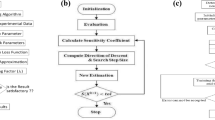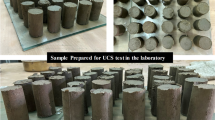Abstract
This paper utilizes various artificial intelligence models to predict the experimental results of the deep-mixing technology for ground improvement and stabilization. A total of 192 unconfined compression strength laboratory experiments were conducted on specimens taken from Khuzestan, Iran, to compare the strength of the soil before and after the treatment with cement. In this research, 144 sets of experimental data, constituting 75% of the total, were used for training, while 48 sets, equivalent to 25% of the experimental data, were utilized for both testing. Different artificial intelligence methods including artificial neural networks, hybrid artificial bee colony-artificial neural networks, combinational group modeling of data handling, and gene expression programming were used. To evaluate the performance of each method, mean squared error, root mean squared error, mean absolute percentage error, mean absolute error, linear correlation coefficient, and coefficient of determination was calculated for each method. Based on the performance analysis, the hybrid artificial bee colony-artificial neural network algorithm outperformed other methods with an R2 calculated as 0.9969 and 0.9952, respectively in training and testing. The R2 values during training for ANN, GMDH, and GEP are 0.993, 0.983, and 0.96, respectively. Likewise, during testing, the R2 values for ANN, GMDH, and GEP are 0.992, 0.978, and 0.953, respectively. The results demonstrated significant agreement between artificial intelligence predictive models and experimental data. Furthermore, this paper provides robust and cost-effective models with a “closed-form solution” for predicting the strength of stabilized soils by the deep mixing technique. The closed-form equation presented in this study, which is derived from the group method of data handling combinatorial algorithm and gene expression programming models, is more intuitive for engineers to apply.















Similar content being viewed by others
Data Availability
The datasets generated during and/or analyzed during the current study are not publicly available due to its huge amount of data but are available from the corresponding author on reasonable request.
References
Porbaha A (1998) State of the art in deep mixing technology: part I. Basic concepts and overview. Proc Inst Civ Eng Gr Improve 2(2):81–92
Terashi M, Miki H (1999) Importance of prediction in ground improvement. In: Predict performance of ground improvement, pp 1–10
Topolnicki M (2016) General overview and advances in deep soil mixing. In: XXIV geotechnical conference of Torino design, construction and controls of soil improvement systems
Spagnoli G et al (2022) Chemical clay soils treatment during deep soil mixing. In: International conference of the international association for computer methods and advances in geomechanics. Springer
Kitazume M, Terashi M (2013) The deep mixing method. CRC Press, Boca Raton
Terashi M (2003) The state of practice in deep mixing methods. In: Grouting and ground treatment, pp 25–49
Hosseini SAA, Mojtahedi SFF, Sadeghi H (2020) Optimisation of deep mixing technique by artificial neural network based on laboratory and field experiments. Georisk Assess Manag Risk Eng Syst Geohazards 14(2):142–157
F. Mojtahedi SF, Ahmadihosseini A, Sadeghi H (2023) An artificial intelligence based data-driven method for forecasting unconfined compressive strength of cement stabilized soil by deep mixing technique. Geotech Geol Eng 41(1):491–514
Shahin MA, Jaksa MB, Maier HR (2009) Recent advances and future challenges for artificial neural systems in geotechnical engineering applications. Adv Artif Neural Syst 2009:308239
Shahin MA, Maier HR, Jaksa MB (2002) Predicting settlement of shallow foundations using neural networks. J Geotech Geoenviron Eng 128(9):785–793
Najafzadeh M, Barani G-A, Kermani MRH (2013) GMDH based back propagation algorithm to predict abutment scour in cohesive soils. Ocean Eng 59:100–106
Kang F, Li J, Ma Z (2013) An artificial bee colony algorithm for locating the critical slip surface in slope stability analysis. Eng Optim 45(2):207–223
Najafzadeh M, Azamathulla HM (2015) Neuro-fuzzy GMDH to predict the scour pile groups due to waves. J Comput Civ Eng 29(5):04014068
Wu XZ (2015) Modelling dependence structures of soil shear strength data with bivariate copulas and applications to geotechnical reliability analysis. Soils Found 55(5):1243–1258
Yousefpour N et al (2021) Stiffness and strength of stabilized organic soils—part ii/ii: parametric analysis and modeling with machine learning. Geosciences 11(5):218
Onyelowe KC et al (2023) Selected AI optimization techniques and applications in geotechnical engineering. Cogent Eng 10(1):2153419
Yousefpour N, Fazel Mojtahedi F (2023) Early detection of internal erosion in earth dams: combining seismic monitoring and convolutional AutoEncoders. Georisk Assess Manage Risk Eng Syst Geohazards 1–21
Mojtahedi FF et al (2023) Spatiotemporal deep learning approach for estimating water content profiles in soil layers. In: E3S web of conferences. EDP Sciences
Sulewska MJ (2017) Applying artificial neural networks for analysis of geotechnical problems. Comput Assist Methods Eng Sci 18(4):231–241
Meyerhof GG (1976) Bearing capacity and settlement of pile foundations. J Geotech Eng Div 102(3):197–228
Schmertmann JH (1986) Dilatometer to compute foundation settlement. In: Use of insitu tests in geotechnical engineering, Geotechnical Special Publication, no 6, pp 303–321
Schultze E, Sherif G (1973) Prediction of settlements from evaluated settlement observations for sand. In: Proceedings eighth international conference on soil mechanics and foundation engineering
Momeni E et al (2015) Prediction of uniaxial compressive strength of rock samples using hybrid particle swarm optimization-based artificial neural networks. Measurement 60:50–63
Alavi AH et al (2010) Multi expression programming: a new approach to formulation of soil classification. Eng Comput 26(2):111–118
Das SK et al (2010) Prediction of swelling pressure of soil using artificial intelligence techniques. Environ Earth Sci 61(2):393–403
Wang O, Al-Tabbaa A (2013) Preliminary model development for predicting strength and stiffness of cement-stabilized soils using artificial neural networks. In: Computing in civil engineering (2013), pp 299–306
Sabat AK (2015) Prediction of California bearing ratio of a stabilized expansive soil using artificial neural network and support vector machine. Electron J Geotech Eng 20(3):981–991
Salvatore E et al (2022) Conditioning clayey soils with a dispersant agent for Deep Soil Mixing application: laboratory experiments and artificial neural network interpretation. Acta Geotech 17(11):5073–5087
Ali Ghorbani M et al (2018) Forecasting pan evaporation with an integrated artificial neural network quantum-behaved particle swarm optimization model: a case study in Talesh, Northern Iran. Eng Appl Comput Fluid Mech 12(1):724–737
Nguyen XC et al (2022) Develo** a new approach for design support of subsurface constructed wetland using machine learning algorithms. J Environ Manag 301:113868
Chen J, Chen Y, Cohn AG, Huang H, Man J, Wei L (2022) A novel image-based approach for interactive characterization of rock fracture spacing in a tunnel face. J Rock Mech Geotech Eng 14(4):1077–1088
Armaghani DJ et al (2020) Hybrid ANN-based techniques in predicting cohesion of sandy-soil combined with fiber. Geomech Eng 20(3):191–205
Simpson P (1990) Artificial neural system-foundation, paradigm, application and implementation. Pergamon Press, New York
Hornik K, Stinchcombe M, White H (1989) Multilayer feedforward networks are universal approximators. Neural Netw 2(5):359–366
Karaboga D (2010) Artificial bee colony algorithm. Scholarpedia 5(3):6915
Karaboga D, Basturk B (2007) A powerful and efficient algorithm for numerical function optimization: artificial bee colony (ABC) algorithm. J Glob Optim 39(3):459–471
Ivakhnenko A, Ivakhnenko G, Andrienko N (1998) Inductive computer advisor for current forecasting of Ukraine’s macroeconomy. Syst Anal Model Simul 31:143–152
Ivakhnenko A (1970) Heuristic self-organization in problems of engineering cybernetics. Automatica 6(2):207–219
Ivakhnenko A, Ivakhnenko G, Muller J (1994) Self-organization of neural networks with active neurons. Pattern Recognit Image Anal 4(2):185–196
Ferreira C (2001) Gene expression programming: a new adaptive algorithm for solving problems. ar**v preprint cs/0102027
Ramesh A, Hajihassani M, Rashiddel A (2020) Ground movements prediction in shield-driven tunnels using gene expression programming. Open Constr Build Technol J 14(1)
ASTM D (2006) Standard test method for unconfined compressive strength of cohesive soil. ASTM standard D, vol 2166
Zhang F et al (2016) Weakly supervised learning based on coupled convolutional neural networks for aircraft detection. IEEE Trans Geosci Remote Sens 54(9):5553–5563
Nguyen HB et al (2017) Particle swarm optimisation with genetic operators for feature selection. In: 2017 IEEE congress on evolutionary computation (CEC). IEEE
Haghiabi AH (2017) Prediction of river pipeline scour depth using multivariate adaptive regression splines. J Pipeline Syst Eng Pract 8(1):04016015
Bui TD, Ravi S, Ramavajjala V (2018) Neural graph learning: training neural networks using graphs. In: Proceedings of the eleventh ACM international conference on web search and data mining
Hu X, Solanki P (2021) Predicting resilient modulus of cementitiously stabilized subgrade soils using neural network, support vector machine, and Gaussian process regression. Int J Geomech 21(6):04021073
Pham BT et al (2019) A novel artificial intelligence approach based on multi-layer perceptron neural network and biogeography-based optimization for predicting coefficient of consolidation of soil. CATENA 173:302–311
Ferreira C (2006) Gene expression programming: mathematical modeling by an artificial intelligence, vol 21. Springer, Berlin
Milne L (1995) Feature selection using neural networks with contribution measures. In: Eighth Australian joint conference on artificial intelligence, AI’95
Funding
The authors declare that no funds, grants, or other support were received during the preparation of this manuscript.
Author information
Authors and Affiliations
Contributions
All authors contributed to the study conception and design. Data collection and analysis were performed by FFM, AA, DRE, MR and GS. The first draft of the manuscript was written by FFM and all authors commented on previous versions of the manuscript. All authors read and approved the final manuscript.
Corresponding author
Ethics declarations
Conflict of interest
The authors have no relevant financial or non-financial interests to disclose.
Additional information
Publisher's Note
Springer Nature remains neutral with regard to jurisdictional claims in published maps and institutional affiliations.
Rights and permissions
Springer Nature or its licensor (e.g. a society or other partner) holds exclusive rights to this article under a publishing agreement with the author(s) or other rightsholder(s); author self-archiving of the accepted manuscript version of this article is solely governed by the terms of such publishing agreement and applicable law.
About this article
Cite this article
Mojtahedi, F.F., Ahmadihosseini, A., Eidgahee, D.R. et al. Bio-inspired Predictive Models Development for Strength Characterization of Cement Deep-Mixed Plastic Soils. Int. J. of Geosynth. and Ground Eng. 10, 9 (2024). https://doi.org/10.1007/s40891-023-00508-0
Received:
Accepted:
Published:
DOI: https://doi.org/10.1007/s40891-023-00508-0




